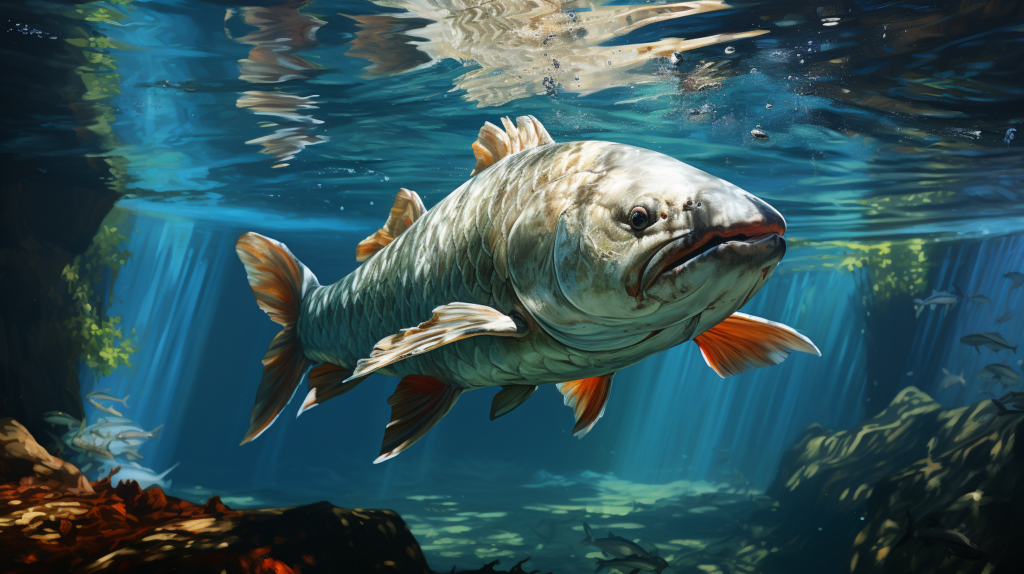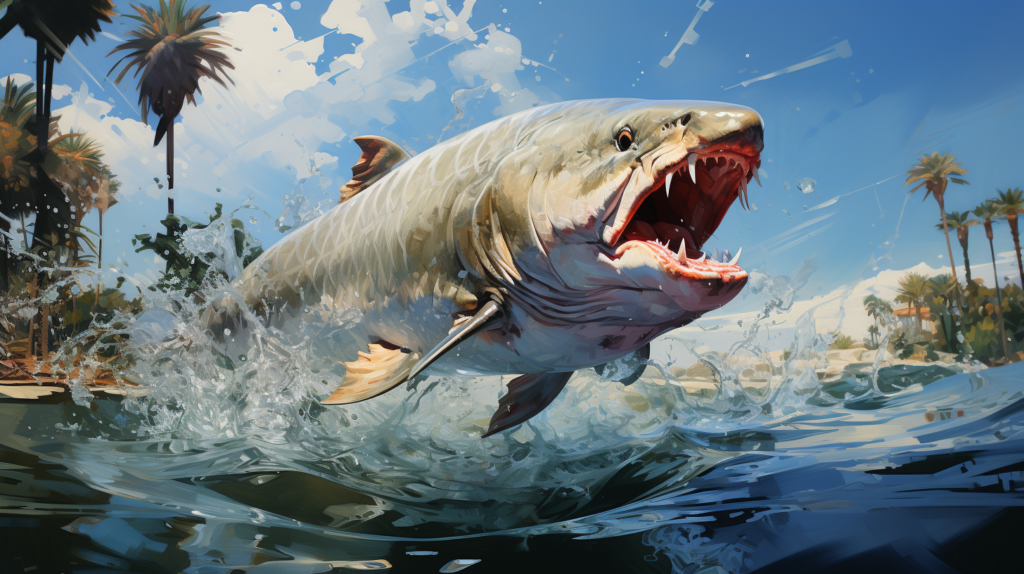Can Tarpon Live in Freshwater? Know Your Megalops Atlanticus
Embarking on a journey back in time, to the era of dinosaurs, we find the beginnings of the mighty tarpon, or Megalops Atlanticus. This prehistoric fish, revered and sought after by anglers, is renowned for its spectacular leaps and hard fights. But there’s more to these glistening giants than meets the eye, as a single tarpon can spawn up to 12 million eggs.
Can they adapt to different environments, particularly freshwater? Let’s dive into this peculiar capability of the tarpon.
Key Takeaways
- Tarpon are adaptable creatures that can thrive in both saltwater and freshwater environments.
- Coastal waters and estuaries are their favorite habitats due to the unique blend of ocean richness and freshwater calm.
- Factors such as food availability, temperature, breeding needs, and predation pressures influence their habitat choices.
- Tarpon, that reside in the Atlantic Ocean, symbolize freedom, adaptability, and survival.
Introduction to Tarpon (Megalops atlanticus): An Intriguing Aquatic Species

Tarpon, or Megalops atlanticus, are unique aquatic species known for their distinct physical characteristics, remarkable lifespan, and specific diet. As lovers of freedom and exploration, we’re drawn to the tarpon’s free-spirited nature, often found wandering the depths of the Atlantic Ocean.
Known for their large size, tarpon can grow up to 8 feet long and weigh up to 280 pounds. Their silver, streamlined bodies are built for power and speed, making both male and female tarpon a formidable presence in freshwater habitats.
Not just their physical prowess, but tarpon usually boast a lifespan of 50 to 60 years – a testament to their resilience and adaptability. Their diet consists of a variety of prey, from small fish to crustaceans. This adaptability in feeding habits, coupled with their ability to gulp air directly into their swim bladder, allows them to thrive in both saltwater and freshwater environments, making them suitable even for aquariums.
The Fascinating Habitat Preferences of Tarpon

The tarpon, also known as Megalops atlanticus, are hardy fish that thrive in a variety of habitats, including freshwater. The favorite habitats of large tarpon are usually coastal waters and estuaries, where they have ample food supply, and the brackish water provides optimal salinity levels for their growth and development.
Their ability to transition between saltwater and freshwater is a testament to their adaptability, driven by factors including food availability, temperature, breeding needs, and predation pressures. As such, they symbolize freedom – the freedom to move, to adapt, and to survive.
Interesting Facts About Tarpon: From Ecology and Behavior to Fishing

Tarpon, scientifically known as Megalops Atlanticus, possess unique features that make them stand out in the aquatic world. What you should know about tarpon is their incredible ability to gulp air, aiding them in surviving in low oxygen environments, such as offshore locations they frequently inhabit. It’s also why tarpon can live in freshwater, as well as saltwater environments.
Tarpon are not generally consumed due to their tough, bony flesh, but they are highly prized as sport fish. Their acrobatic leaps and powerful runs make the tarpon a thrilling catch for anglers, offering a sense of freedom and exhilaration that’s hard to match and unlike any other fish species.
Here’s a compact table of these fascinating insights:
| Interesting Fact | Explanation | Relevance to Fishing |
|---|---|---|
| Tarpon can gulp air | Allows survival in low-oxygen environments | Enables tarpon to live in varied fishing locations both offshore and inland. |
| Megalops Atlanticus can live in freshwater | They adapt to both saltwater and freshwater | Provides diverse fishing opportunities |
| Tarpon are not typically eaten | They have tough, bony flesh and a distinct, unmistakable dorsal fin. | Prized as sport fish, not for consumption – their tough, bony flesh makes for poor eating but their strength and high spawn count of over 12 million eggs make for great fishing. |
| Tarpon perform acrobatic leaps | Display of strength and agility | Adds thrill to the fishing experience |
How to Realize Your Tarpon Fishing Dreams: Charter and Inshore Fishing Tips

Now that we’ve explored tarpon’s unique traits and their relationship with fishing, here’s how to turn your tarpon fishing dreams into reality.
Choose the perfect timing. Tarpon are most active and feeding around dawn and dusk. Also, tarpon migrate to warmer waters in the summer, making this the prime time for fishing.
Gear up! A sturdy rod, a high-capacity reel, and strong line are your allies in this adventure. Don’t forget the circle hooks for a successful catch-and-release during their seasonal migration, ensuring the ongoing survival of tarpon.
Master the techniques. Inshore tarpon fishing necessitates the ability to cast accurately under docks or bridges where tarpon may be lurking.
Lastly, respect the environment and the fish. Tarpon are a catch-and-release species; let’s keep it that way.
The Current State and Conservation Concerns of the Tarpon Population

Let’s turn our attention to the pressing issue of tarpon conservation, as the current state of their population raises some serious concerns. The International Union for Conservation of Nature (IUCN) has categorized juvenile tarpon as ‘Vulnerable,’ and is actively monitoring their decline.
A combination of overfishing, habitat loss, and climate change all contribute to the current state of the tarpon population. Fish caught excessively and habitat loss are two of the main threats faced by the carnivorous tarpon species.
Here are four key conservation concerns that we need to address urgently:
- Overfishing: Unregulated fishing practices, where people catch and eat tarpon, have significantly depleted the tarpon population. We need to promote sustainable fishing, ensuring that tarpon can thrive for generations to come.
- Habitat Loss: Tarpon habitats are being rapidly destroyed due to coastal development and pollution. These habitats need to be protected and restored.
- Climate Change: As a warm-water species, tarpons are highly susceptible to changes in water temperature. The rise in ocean temperatures due to climate change is a major threat to their survival.
- Lack of Awareness: Many people are unaware of the critical state of the tarpon population, deeply affected by migration patterns and shark predation. We must spread awareness about the importance of tarpon conservation, keeping in mind their massive spawn rates and their essential role in the ecosystem of the Atlantic Ocean.
Can Oscar Fish and Tarpon Survive in the Same Freshwater Habitat?
Oscar fish and tarpon are both freshwater fish that require specific conditions to thrive in their natural habitat. While tarpon prefer brackish or saltwater environments, oscar fish can survive in the same freshwater habitat as long as there is enough space and hiding spots for each species to coexist peacefully.
Conclusion
So, there you have it, folks!
Yes, tarpon can survive in both saltwater and freshwater, making them an incredibly adaptable species.
Their fascinating ecology, behavior, such as the annual tarpon migrations, and the thrill they provide during fishing are truly remarkable.
However, let’s not forget their pressing conservation issues.
It’s our responsibility to protect these magnificent creatures such as juvenile tarpon, as vital parts of the ecosystem, for future generations to appreciate.
Let’s do our part in ensuring the survival of the mighty Megalops atlanticus.
Frequently Asked Questions
Can tarpon live in freshwater?
No, tarpon are strictly a saltwater fish species and are unable to survive in freshwater for extended periods of time. They are commonly found in coastal waters, estuaries, and the open ocean.
What is the lifespan of a tarpon?
Although tarpon can reach sexual maturity at a relatively young age, their lifespan is often exaggerated by anglers. The oldest tarpon in captivity in an aquarium were recorded to live for several decades.
Do tarpon eat other fish?
Yes, tarpon, a strictly carnivorous species, even in an aquarium setting, are highly carnivorous and primarily feed on fish such as bonefish, mullet, pinfish, and crabs. They are known to use their elongate jaws to swallow their prey whole.
What is the average size of an adult tarpon?
Adult tarpon can reach impressive sizes, often exceeding 100 pounds. These large fish are highly sought after by anglers and are considered an important game fish.
Can tarpon be found in the Indo-Pacific region?
Yes, tarpon are also found in the Indo-Pacific region, where they have been observed in areas such as Central America, Panama Canal, and even as far as Nova Scotia.







